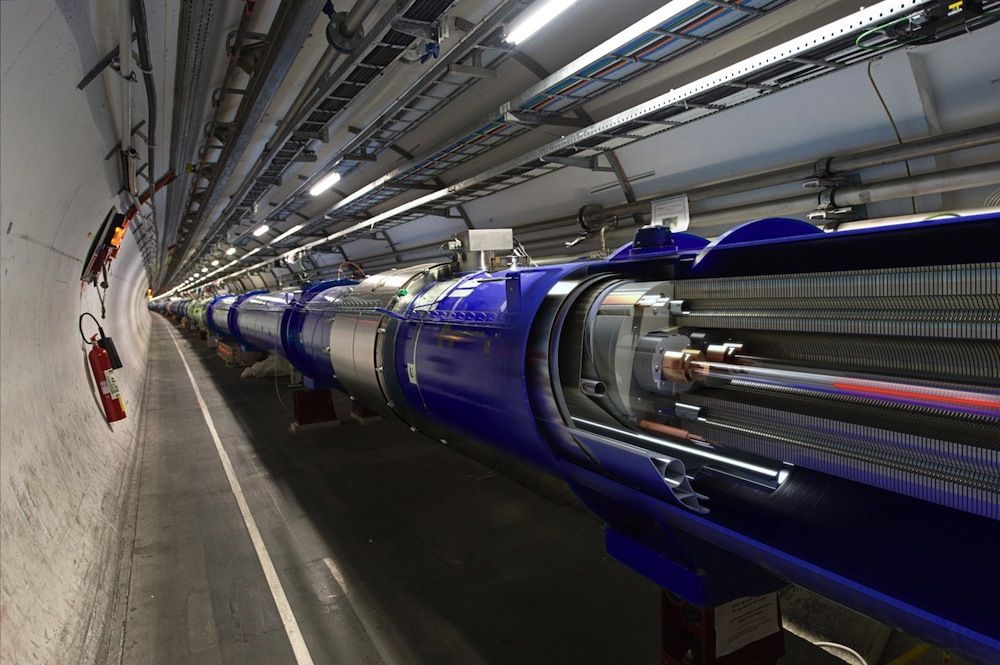
Editor's Note: This story was updated at 10:30 a.m. E.T.
Ready, set, go! The hunt for new subatomic particles is officially on.
The world's largest atom smasher is finally producing new data, after a two-year hiatus and months of test collisions at mind-boggling energies. The new run of the collider could reveal hints of dark matter, extra dimensions or completely new particles.
The Large Hadron Collider (LHC), a 17-mile (27 kilometers) underground ring between France and Switzerland, speeds protons to within a hair's breadth of the speed of light before they crash into each other. These collisions produce an alphabet soup of subatomic particles that exist only fleetingly. By combing through the subatomic debris from these collisions, physicists can potentially identify new particles or explain mysteries about how existing particles work.
The particle collider gained worldwide fame in 2012, when LHC scientists announced they had discovered the Higgs boson, the long-sought-after particle that explains how other particles get their mass. Shortly after the discovery, the LHC was shut down so that physicists could upgrade the equipment to handle collisions at double the energy of its previous run, from 6.5 teraelectronvolts (TeV) to 13 TeV. [See Photos of the World's Largest Atom Smasher]
The LHC first revved up again after the hiatus in April, producing proton collisions at the 13 TeV level. But those trial runs were simply ensuring that stray protons racing around the ring didn't damage nearby equipment.
The LHC sends 100 billion to 1 trillion protons around the ring at a time, and some will naturally be of slightly different energy levels than their nearest neighbors, Greg Rakness, run coordinator for one of the experiments called CMS at the collider, previously told Live Science. As a result, they may arc around the circle at a slightly different angle and hit off-target locations, like the expensive, delicate equipment within the ring.
Sign up for the Live Science daily newsletter now
Get the world’s most fascinating discoveries delivered straight to your inbox.
To keep those rogue protons in line, the team strategically places hunks of metal, called collimators, throughout the ring. The last two months of testing determined where to put those collimators to absorb energy from errant protons.
The tests also ensured that all 9,600 magnets keeping speedy protons on target were working properly.
Now, the LHC is finally ready for show time.
At around 10:40 a.m. local time today (June 3) in Switzerland, "stable beams" of 100 billion protons were reported in the ring at 450 gigaelectronvolts (GeV). The protons whizzed around, getting a slight bump in energy at each of the 10,000 radiofrequency cavities placed throughout the vacuum-sealed ring, said Phillippe Baudrenghien, a physicist at CERN, in a live webcast of the run.
"Each time the protons enter the cavity they get a little kick," Baudrenghien said. But with so many runs around the ring, those little bumps add up, taking the low-energy beam to its peak of 13 TeV, he added.
Eventually, the LHC will ramp up to produce as many as 1 billion collisions per second, CERN officials said in a statement.
In the first attempt earlier in the day, the LHC ran into a hiccup, when the researchers lost the beams after sensor that measures beam position went a little crazy, but they eventually got the experiment back on track.
Now that the atom smasher is up and running, it should be hunting for new physics at the higher energy level for the next three years. The new run is powerful enough to spot even heavier particles than the previous run, said David Charlton, the spokesman for the ATLAS collaboration, which discovered the Higgs boson.
Editor's Note: This story was edited to explain what caused the initial hiccup when the LHC was first restarted.
Follow Tia Ghose on Twitter and Google+. Follow LiveScience @livescience, Facebook & Google+. Originally published on Live Science.

Tia is the managing editor and was previously a senior writer for Live Science. Her work has appeared in Scientific American, Wired.com and other outlets. She holds a master's degree in bioengineering from the University of Washington, a graduate certificate in science writing from UC Santa Cruz and a bachelor's degree in mechanical engineering from the University of Texas at Austin. Tia was part of a team at the Milwaukee Journal Sentinel that published the Empty Cradles series on preterm births, which won multiple awards, including the 2012 Casey Medal for Meritorious Journalism.









